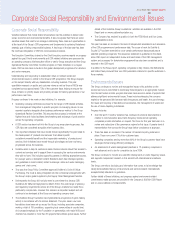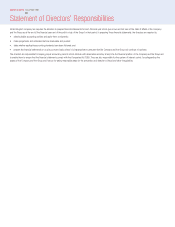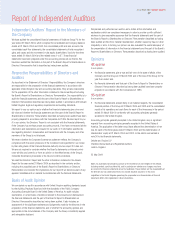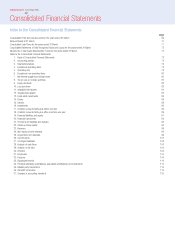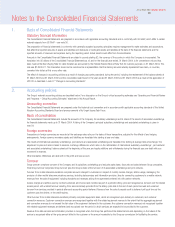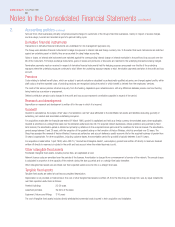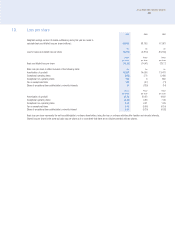Vodafone 2004 Annual Report Download - page 75
Download and view the complete annual report
Please find page 75 of the 2004 Vodafone annual report below. You can navigate through the pages in the report by either clicking on the pages listed below, or by using the keyword search tool below to find specific information within the annual report.
Annual Report 2004 Vodafone Group Plc
73
1. Basis of Consolidated Financial Statements
Statutory financial information
The Consolidated Financial Statements are prepared in accordance with applicable accounting standards and in conformity with UK GAAP, which differ in certain
material respects from US GAAP – see note 36.
The preparation of financial statements in conformity with generally accepted accounting principles requires management to make estimates and assumptions
that affect the reported amounts of assets and liabilities and disclosure of contingent assets and liabilities at the date of the financial statements and the
reported amounts of revenues and expenses during the reporting period. Actual results could differ from those estimates.
Amounts in the Consolidated Financial Statements are stated in pounds sterling (£), the currency of the country in which the Company is incorporated. The
translation into US dollars of the Consolidated Financial Statements as of, and for the financial year ended, 31 March 2004, is for convenience only and has
been made at the Noon Buying Rate for cable transfers as announced by the Federal Reserve Bank of New York for customs purposes on 31 March 2004. This
rate was $1.8400: £1. This translation should not be construed as a representation that the sterling amounts actually represented have been, or could be,
converted into dollars at this or any other rate.
The effect of changes in accounting policies as a result of changing accounting standards during the period, including the restatement of the balance sheets at
31 March 2003 and 31 March 2002 and the consolidated cash flows for the years ended 31 March 2003 and 31 March 2002 as a result of the application of
UITF 38, is described in note 37 “Changes in accounting standards”.
2. Accounting policies
The Group’s material accounting policies are described below. For a discussion on the Group’s critical accounting estimates see “Operating and Financial Review
and Prospects – Critical Accounting Estimates” elsewhere in this Annual Report.
Accounting convention
The Consolidated Financial Statements are prepared under the historical cost convention and in accordance with applicable accounting standards of the United
Kingdom Accounting Standards Board and pronouncements of its Urgent Issues Task Force.
Basis of consolidation
The Consolidated Financial Statements include the accounts of the Company, its subsidiary undertakings and its share of the results of associated undertakings
for financial statements made up to 31 March 2004. A listing of the Company’s principal subsidiary undertakings and associated undertakings is given in
note 34.
Foreign currencies
Transactions in foreign currencies are recorded at the exchange rates ruling on the dates of those transactions, adjusted for the effects of any hedging
arrangements. Foreign currency monetary assets and liabilities are translated into sterling at year end rates.
The results of international subsidiary undertakings, joint ventures and associated undertakings are translated into sterling at average rates of exchange. The
adjustment to year end rates is taken to reserves. Exchange differences, which arise on the retranslation of international subsidiary undertakings’, joint ventures’
and associated undertakings’ balance sheets at the beginning of the year, and equity additions and withdrawals during the financial year, are dealt with as a
movement in reserves.
Other translation differences are dealt with in the profit and loss account.
Turnover
Group turnover comprises turnover of the Company and its subsidiary undertakings and excludes sales taxes, discounts and sales between Group companies.
Total Group turnover comprises Group turnover plus the Group’s share of the turnover of its associated undertakings and joint ventures.
Turnover from mobile telecommunications comprises amounts charged to customers in respect of monthly access charges, airtime usage, messaging, the
provision of other mobile telecommunications services, including data services and information provision, fees for connecting customers to a mobile network,
revenues from the sale of equipment, including handsets and revenues arising from agreements entered into with partner networks.
Access charges and airtime used by contract customers are invoiced and recorded as part of a periodic billing cycle and recognised as turnover over the related
access period, with unbilled turnover resulting from services already provided from the billing cycle date to the end of each period accrued and unearned
turnover from services provided in periods after each accounting period deferred. Revenue from the sale of prepaid credit is deferred until such time as the
customer uses the airtime, or the credit expires.
Other turnover from mobile telecommunications primarily comprises equipment sales, which are recognised upon delivery to customers, and customer
connection revenues. Customer connection revenues are recognised together with the related equipment revenue to the extent that the aggregate equipment
and connection revenues do not exceed the fair value of the equipment delivered to the customer. Any customer connection revenues not recognised together
with related equipment revenues are deferred and recognised over the period in which services are expected to be provided to the customer.
Revenue from data services and information provision is recognised when the Group has performed the related service and depending on the nature of the
service is recognised either at the gross amount billed to the customer or the amount receivable by the Group as commission for facilitating the service.
Notes to the Consolidated Financial Statements




